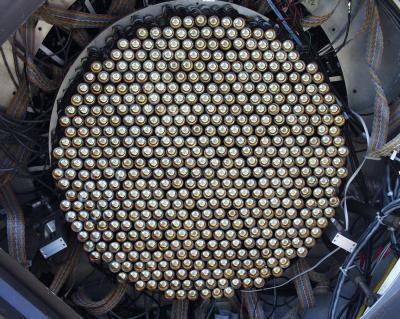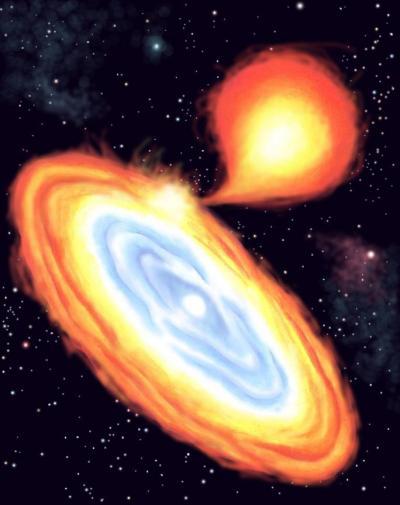The brightest stellar explosion ever recorded may be a long-sought new type of supernova, according to observations by NASA's Chandra X-ray Observatory and ground-based optical telescopes.
Heavens
Chefs have long used a simple trick to differentiate between a raw and hard-boiled egg. By spinning an egg and watching how it behaves when the spin is disrupted, it's easy to tell whether its interior is solid or liquid.
Applying a similar test to the planet Mercury, astronomers have found strong evidence that the planet closest to the sun has a fluid core. The research, led by Jean-Luc Margot, assistant professor of astronomy at Cornell, appears this week on the Web site of the journal Science.
COROT has provided its first image of a giant planet orbiting another star and the first bit of ‘seismic’ information on a far away, Sun-like star- with unexpected accuracy.
New observations by the NASA/ESA Hubble Space Telescope have overturned conventional ideas about the early life of some massive globular clusters, showing that they can go through several periods of intense stellar formation rather than the previously accepted single burst.
Want to know if the International Space Station is over you right now? You can view the location of ESA's Earth-orbiting spacecraft and other ESA-related missions in real-time via a new tracking site.![]() Credits: ESA
Credits: ESA
Once the site loads, the tracker automatically starts displaying the location of the International Space station (ISS) and various observation missions.
Astronomers have discovered the most Earth-like planet outside our Solar System to date, an exoplanet with a radius only 50% larger than the Earth and capable of having liquid water. Using the ESO 3.6-m telescope, a team of Swiss, French and Portuguese scientists discovered a super-Earth about 5 times the mass of the Earth that orbits a red dwarf, already known to harbour a Neptune-mass planet.
NASA's Solar TErrestrial RElations Observatory (STEREO) satellites have provided the first three-dimensional images of the sun. For the first time, scientists will be able to see structures in the sun's atmosphere in three dimensions. The new view will greatly aid scientists' ability to understand solar physics and there by improve space weather forecasting. This web page contains 3-D anaglyph video and images.
Warm gas escaping from the clutches of enormous black holes could be the key to a form of intergalactic 'pollution' that made life possible, according to new results from ESA. The gas that escapes contains elements heavier than hydrogen or helium and is positively ionized, including carbon, the essential element for life on Earth.
There's a "First Light Fiesta" in the works at Mt. Hopkins near Amado, Ariz. And Iowa State University astrophysicists will be among those enjoying the celebration of a new telescope system and all the science it will produce. Iowa State University astrophysicists designed and built four of these cameras for the VERITAS gamma ray telescope system. Each camera contains 500 tube-shaped photo detectors. Credit: Photo contributed by Frank Krennrich/Iowa State University
Iowa State University astrophysicists designed and built four of these cameras for the VERITAS gamma ray telescope system. Each camera contains 500 tube-shaped photo detectors. Credit: Photo contributed by Frank Krennrich/Iowa State University
A new theoretical thermometer built from heavy-duty mathematics and computer code suggests that the surfaces of certain neutron stars run significantly hotter than previously expected. Hot enough, in fact, to at least partially answer an open question in astrophysics -- how to explain the observed frequency of ultra-violent explosions known as superbursts that sometimes ignite on such stars' surfaces? Neutron star accreting matter from a red giant star.
Neutron star accreting matter from a red giant star.
A remarkable eclipse of a supermassive black hole and the hot gas disk around it has been observed with NASA's Chandra X-ray Observatory. This eclipse has allowed two key predictions about the effects of supermassive black holes to be tested.
NASA scientists believe they have found a way to predict the color of plants on planets in other solar systems.
Using a trio of space observatories, astronomers may have cracked a 45-year old mystery surrounding two ghostly spiral arms in the galaxy M106 (NGC 4258).
The double sunset that Luke Skywalker gazed upon in the film "Star Wars" might not be a fantasy.
Astronomers using data from several X-ray satellites have caught a magnetar – the remnant of a massive star with an incredibly strong magnetic field – in a sort of giant cosmic blench.